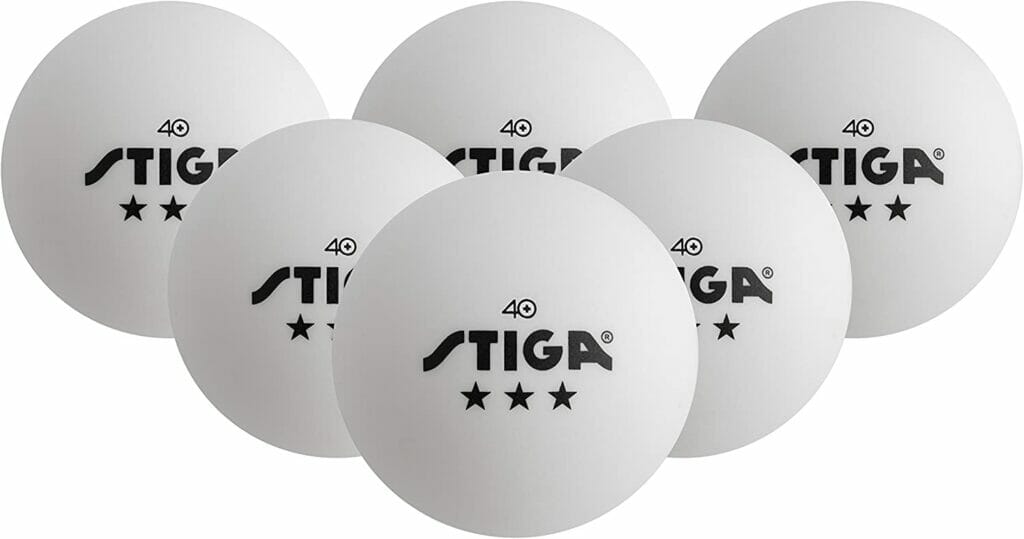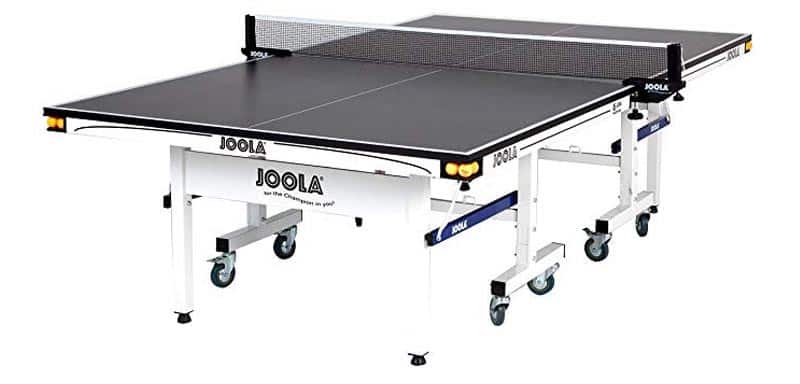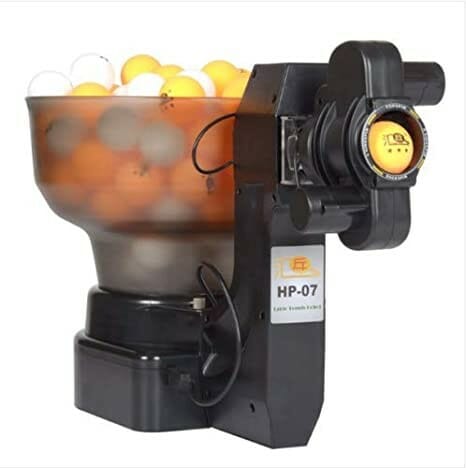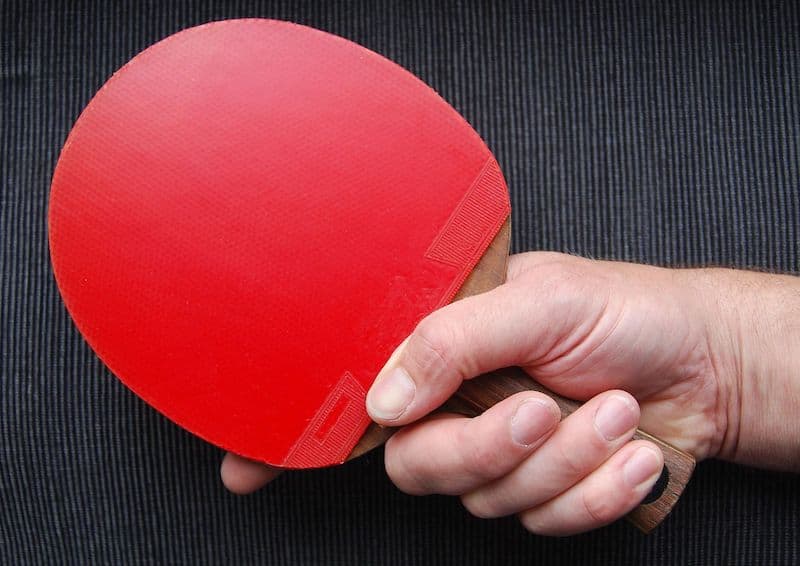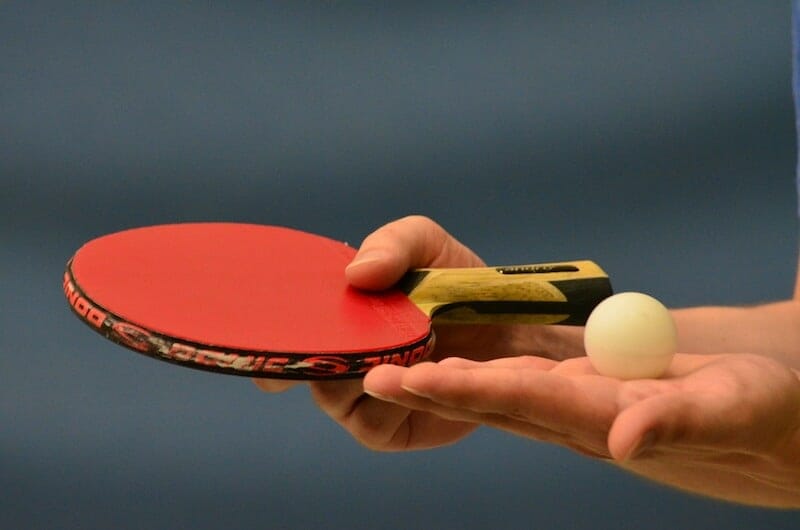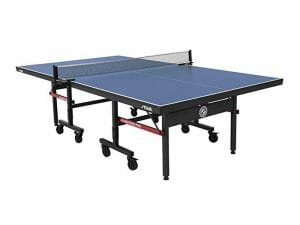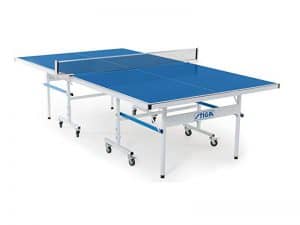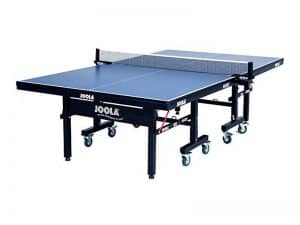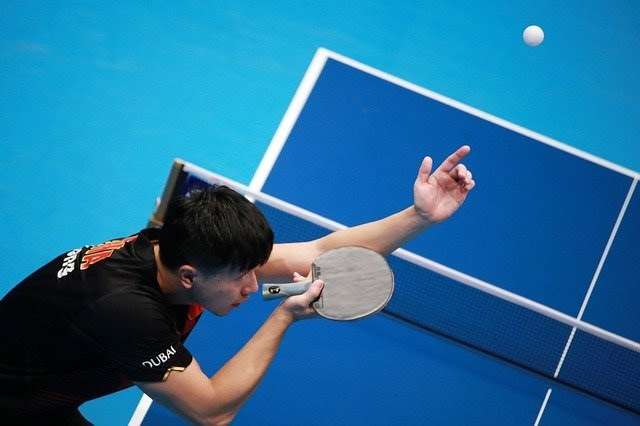How To Play Ping Pong: A Beginner’s Guide
- Alex Horscroft
- Last updated
So you want to learn how to play ping pong, huh? Or would it be more correct to call it table tennis? In all honesty, it really doesn’t matter. Players use the two terms synonymously these days.
I’ve been playing table tennis for over a decade and still can’t get enough of this beautiful game. And I want to share this passion with you. Today, we will cover all of the basic elements you need to know as a beginner to kickstart your table tennis journey.
Do you want more advanced coaching?
- 20+ Hours of Training
- From Beginner to Master
- Coached by Chinese National Champion
Table of Contents
What Equipment Do You Need?
Like almost every sport, you must first acquire the equipment needed to enjoy it. There are only three basic items you must purchase when it comes to learning how to play table tennis for beginners.
Ping Pong Paddles
Watch the video for 5 great beginner and intermediate paddles under $55!
You play table tennis by striking the ball with a paddle which is sometimes known as a bat or a racket depending on where you live. A ping pong paddle is made up of four different parts:
- The handle – This is the part of the paddle that you hold. It can come in a variety of different sizes and shapes that can affect your gameplay.
- The blade – The blade of a ping pong paddle is the main body of the bat and is constructed by using multiple layers of wood (and sometimes carbon).
- Sponge layer – Sitting on top of the blade is a thin layer of sponge (typically between 1.2 mm and 2.2 mm. As a beginner, you want to look for a paddle with a thinner layer of sponge as this will give you more control over the ball.
- The rubber – Finally, sitting on top of the sponge is a layer of rubber which is what actually makes contact with the ball. There are a variety of different rubbers to suit different styles of play. To learn more, check out our guide to table tennis rubbers here.
Ping pong paddles are usually rated on three qualities: control, spin, and speed. Beginners should look for a paddle with a high control rating and low spin and speed ratings. As you improve and get better at controlling the ball, you can look for a racket with lower control with more speed and grip so that you can more easily put spin on the ball and hit it faster. Click here to see our list of the top ping pong paddles of this year.
Ping Pong Balls
Like a lot of other sports, to play table tennis, you’ll need balls to practice and compete. Ping pong balls are small, round, and made out of plastic. The standard regulation size is ever so slightly more than 40 mm, and typically, they come in two different colors: white and orange.
Table tennis balls are generally rated in quality by a star system from 1-3 stars. 1-star balls are inexpensive and used for recreational play, whereas 3-star balls are more expensive and are used for matches and tournaments. While advanced players mostly use 3-star balls, ping pong beginners don’t necessarily need balls of this quality. Feel free to save some money by purchasing some cheaper balls.
For more information check out our table tennis guide for balls here.
Ping Pong Tables
Ping pong tables are one of the more expensive bits of equipment you’ll need. You can spend anywhere from a couple of hundred dollars to a few thousand for a top-of-the-range competition-grade table tennis table. If you’re looking to buy your own one then check out our top-rated ping pong tables list here. But you don’t necessarily need to buy your own as bars, sports centers, and clubs often have tables.
You can also get ping pong conversion tops that sit on top of other tables and allow you to get the quality of a real table without taking up as much space.
Other Accessories You Might Want
While not essential to start playing, you might want to look into a few other accessories and table tennis gear.
A good pair of shoes – For beginners, most sports or gym shoes will work fine, but, as you progress and play more, you might want to invest in a pair of shoes designed specifically with ping pong players in mind.
A paddle case – Table tennis bats aren’t the strongest and can get damaged easily by water, dust, and getting knocked. We always recommend picking up a table tennis paddle case to keep your racket safe when you’re not using it.
A ping pong robot – If you begin to take your game more seriously and want to practice even more then you can buy a table tennis robot. It’s a piece of kit that will fire balls at you to allow you to practice your shots.
How to Play Table Tennis Step by Step
Now that you have the basic equipment down, it’s time to put that stuff to good use and have some fun. First things first, how do you hold your bat?
How to Hold the Bat
The first thing to do before starting play is to make sure you’re holding the paddle correctly. There are two main ways to grip your bat in table tennis: Shakehand and penhold grip. Each grip has its pros and cons but most experts recommend that the best grip for beginners is the shakehand grip.
To read more about how to hold the paddle check out our ping pong guide on grips here. We also have some ping pong instructions regarding bat care that you might find helpful.
Learn the Basic Rules
The basic table tennis rules are important to know when starting out. There are a ton of rules out there for ping pong but you don’t need to know all of them right now. If you don’t feel like reading them, or you feel as if you will probably forget, you can always have someone at a club explain the rules to you better while you are playing.
How You Play a Game of Ping Pong
- When you and another person play a set of games, it is called a “table tennis match”. A match usually consists of the best of three out of five games; so you could end up playing anywhere from three to five games in total.
- In open play (after serving), you must strike the ball onto your opponent’s side of the table tennis table after it has bounced once on your side. If it bounces twice, you volley, or miss the ball, you lose the point.
- The player who serves first is usually determined differently depending on the club (e.g. a coin flip, hide the ball in one hand, etc). Once a player is chosen they will serve for two points and then the opponent will serve for two points.
- In a game, if you and your opponent both reach 10 points (sometimes called “deuce”), the serving rules change. From this point onwards each player will serve once instead of twice.
- You will take turns serving until one player takes a 2-point lead, upon which point they have won the game.
- After each game concludes, the players then switch sides of the table tennis table, but the service always starts on the same side.
How to Serve the Ball
The official rules around serving from the ITTF can be a little overwhelming, so we’ve summarised the basic rules of a legal table tennis serve below.
- The serve should begin with the ball in an open palm – This is to prevent players from spinning the ball as they toss it.
- You must throw the ball in the air at least 6 inches – This is to prevent players from serving quickly or hiding the ball to deceive their opponent.
- You must strike the ball behind the end line of the table – This is to prevent players from getting very close to the net before serving.
- You must not obscure the ball at any point – This is to ensure your opponent can see the ball and have a fair chance of reading your serve.
- Once contact is made, the ball must bounce on your side of the table, bounce over the net, and then bounce on the opponent’s side – You can’t hit it straight over the net.
- If your service adheres to the rules but strikes the net, a let is called – You then get to re-take your serve.
- If you fail to play a legal service, you lose a point – There are no second serves in table tennis.
If you want to learn more about serving, we have a longer, more in-depth ping pong tutorial about the different types of serves.
How to Play Doubles
Doubles build upon the rules of singles, and while there are a few extra rules to follow, they are not that hard to get your head around. The first different rule is that each table tennis player hits the ball once, and then their partner does the same. Contrary to popular belief, whoever is closest cannot strike the ball. It must be alternating.
Another key doubles rule is for serving. Unlike singles, where you can serve anywhere, you must hit the ball cross-court in doubles so that it goes from your right side of the table tennis table to the opponent’s right side. Failure to do so results in you losing a point.
The next two rules are a little more complex, so I’ll break them down. Let’s begin with the order of play. When a game begins, and a server is randomly decided, the receiving team chooses who to receive. This decides the order of play which will remain throughout the game. After a player has finished serving, the service alternates along to the next player in the sequence. For example, the receiver becomes the server, and the server does not receive the ball. Instead, they hit the ball last.
Imagine a team of A and B vs X and Y. The sequence begins A, X, B, Y. After four serves, the order is now B, Y, A, X. As you’ll notice, the sequence has not changed, and after another 4 serves, every player will have served, and we will be back to where we started with A, X, B, Y.
Another rule that is easy to forget for doubles is one that only applies to matches that go to the last game e.g. a fifth game at 2-2. For these, like in singles, you swap ends when the first team reaches 5 points. However, in doubles, the receiving team also swaps roles. The player receiving the serve instead hits the ball fourth in the sequence. This is the only time you will ever break the hitting sequence mid-game.
Some Other Ping Pong Rules to Know
Here are some rules that you might see come up while playing. If someone hits the ball to you and it lands on the very end of the table (even if it barely hits it and goes straight to the floor), it would be the other person’s point. While it’s almost impossible to return, it doesn’t happen often to where it’s a problem. However, this only applies if it makes contact with the top surface of the table. If instead, the ball makes contact with the end of the table at the side, the opponent loses the point. This is because it has not made contact with the playing area.
Also, if your opponent strikes the ball and it hits the net (not on a serve) and doesn’t bounce more than an inch on your side, and you fail to make a return, it’s their point. These kinds of shots are tricky to counter and can be kind of ridiculous sometimes, but they are a part of the game.
A rarer circumstance you might find yourself in is accidentally volleying the ball before it bounces — probably because you didn’t have time to react. In this situation, it all depends on where you hit the ball, even if it looks like it’s going out. If you strike the ball before the end line, it’s your opponent’s point, but if, on the other hand, it’s past the end line, it’s your point.
How to Play Ping Pong for Beginners — Learn the Fundamental Shots
Now we are on to the main body of table tennis — the shots you will perform in open play. You’ve probably seen all kinds of crazy shots that you want to try but let’s not get carried away. You need to learn to walk before you can run. If you’re committed, you’ll get to those crazy shots soon enough.
To start off with, there are four main shots you need to become comfortable with before you can move on to techniques of a higher difficulty. These are the push, block, drive, and smash. I won’t go into too much detail as we cover some of these in our basic table tennis skills post. But essentially, all four of these shots cover your bases in all areas of table tennis as a beginner:
- Push: A defensive shot using backspin. Great for slowing down games against attackers.
- Block: A defensive shot against topspin. Perfect for defending attacking shots when you want to play passively or don’t have the time to counter-attack.
- Drive: Your main topspin attacking stroke. It uses moderate topspin and is easy to perform.
- Smash: Your kill shot. End the rally with a smash when your opponent pops the ball up too high.
Pushing
To perform a push, the incoming ball must either be neutral or have backspin. Incoming topspin strokes instead require a chop to impart backspin. We’ll tackle backhand pushes as they are easier than forehand pushes.
As the ball approaches, ensure your feet are slightly bent and around parallel to the table. And then, with your bat in front of your body at around belly button level, open your bat face so that it is facing the ceiling.
Then strike through the ball, focusing on contacting the bottom part of the ball (not the back of the ball). Follow through even after you make contact. The angle at which your bat is facing depends on the incoming backspin level. The greater the backspin, the more open your bat should be. Check out this great video by Ping Skills below, which breaks the shot down.
Blocking
Next up, we’ll look at backhand blocking — most players tend to block more on their backhand than their forehand side. However, you need to be able to block on your forehand and backhand, as both are key strokes for the game. You use blocks against incoming shots that have topspin or no spin. You cannot use them against backspin strokes.
The start of the backhand block is the same as the backhand push. Bent legs, parallel feet to the table, and your bat in front of you at around belly button level. However, as you are likely facing an incoming topspin shot, you instead need to close your bat angle rather than open it. As you hit the ball, push your bat forward and slightly up in the direction you want to play. Again, the angle of your bat depends on the level of incoming spin. The greater the topspin and speed, the more you need to close your angle. You don’t need to flick your wrist to put spin on the ball as you do with many other shots.
Again, Ping Skills have another great video breaking down the technique.
Driving
You can perform drives against any topspin or no-spin balls and even against balls with light backspin. For this brief breakdown, we’ll look at forehand drives, as these are more popular than backhand drives.
The setup changes quite a bit from the other two shots we just looked at. As you’re playing a forehand stroke, your dominant foot should be slightly behind your other foot. Your bat should also start in the ready position — around a 90-degree bend at the elbow in front of you.
As the ball approaches, drop your non-dominant shoulder slightly, twist your hips backward, and transfer some of your weight onto your back leg. Like with the block, you want to close your bat angle relative to the amount of incoming topspin. Once the ball is at the top of the bounce, you’re essentially reversing your initial movement. To aid in striking the ball, your non-dominant shoulder returns to its original position, you untwist your hips and transfer some of your weight back to your non-dominant leg.
And like the push and block, you follow through with the stroke. Your bat should go forwards and upwards finishing at around shoulder level. Tom Lodziak does a great job of explaining this technique.
Smashing
How to ping pong smash? As mentioned earlier, smashing is your method of punishing your opponent’s mistakes with a point-ending stroke. You can perform a smash against any kind of shot provided it’s high enough —even shots with heavy backspin. You don’t need to learn to forehand and backhand smash if you don’t want to. Backhand is far harder, and you always have time to move around to play a forehand smash instead of a backhand. As such, we will go over the technique for forehand.
Think of the forehand smash a bit like a forceful forehand drive — there are some similarities between the two strokes. Like with the drive, your dominant foot should be further back than your non-dominant foot — except the distance between the two tends to be larger. As for the contact of the ball, it’s a bit different. The ball bounces higher than for the drive, and you don’t always want to strike it at the top of the bounce.
Instead hit the ball when it is at around shoulder height. This gives you the best angle to apply a lot of pace with a high chance of success. To get adequate speed, you need to have more explosive movement. To get this, you should face the ball more side on, which allows you to rotate your shoulder and hips more. Also, because you have a higher margin for error, you can strike through the ball far harder than with the drive.
Again, watch Tom Lodziak’s video where he breaks down his top forehand smashing tips!
Learn From The Best!
My strongest piece of advice is to seek out free knowledge (or pay for it if you like) wherever you can get it. YouTube videos are a great place to start. There are thousands of table tennis videos to watch that can help you learn how to improve your ping pong technique.
Find a Club
One of the best ways to enjoy ping pong is to join a club. I recommend that you try using the internet to your advantage. Look for the closest club in your area, and if they have an updated number on file, try to call them to ask where and when they play. That’s where I get most of my practice. I’ve been playing ping pong at the same club for over a decade now.
Most of the time, clubs have a large, diverse player base. If you’re afraid that you’re too old or too young to go, you shouldn’t worry. There are usually plenty of people aged anywhere from 10 to 60+ that play regularly (and the older guys can be really good, too!).
For most people, playing at clubs is one of the fastest ways to improve your skills in the smallest amount of time. As an advanced player who has been playing for over a decade, I love helping out newbies! Not only does getting pally with better players help spot the mistakes you can’t, but they’ll also show you the right technique.
Furthermore, sometimes clubs host tournaments, or they can tell you where the closest one is. Club tournaments provide great experiences, and they are a ton of fun. People from all around the area, sometimes hours away, will drive to these tournaments to play. It’s really interesting to see how everyone performs in a more official setting.
Some people will have crazy serves, wild hits, or just play in a way you’ve never seen before. If you think you’re good enough, you can enter such a tournament, but don’t get discouraged if you lose. There is a lot of really tough competition out there.
FAQs
How Do You Play Ping Pong?
To play ping pong, you need a bat, a ball, a table tennis table, and a playing partner. Each player serves twice before switching and must make the ball bounce once on their side and once on their opponent’s side. After serving, each player must strike the ball after it has bounced once on their side back onto their opponent’s side of the ping pong table. If either player fails to make a return, they lose the point. First to 11 points wins the game, and you must win by 2 clear points. First to either 2 or 3 games is the norm.
Can My Opponent Hit the Ball in the Air Before it Hits His/Her Side of the Table?
No, your opponent must wait for the ball to bounce on the side of the ping pong table before striking it. If they volley the ball, they have obstructed the ball’s path, so you would receive the point.
Does the Serve Have to be Diagonal?
Diagonal serving is only a requirement for doubles games. Players must serve diagonally from the right rectangle on their side of the table to the right rectangle on their opponent’s side. The server loses the point if the ball bounces outside of either of these two areas. By comparison, for a singles table tennis match, you can serve anywhere on the table.
How Do I Get Points In Ping Pong?
You get points in ping pong by playing shots that your opponent cannot return. This is either because they fail to hit the ball, it bounces twice on their side of the table, or they fail to strike the ball back onto your side of the table. They could also commit a foul, which may cause the umpire to award you a point.
Am I Allowed to Take Three Serves?
No. Each player has two serves. The only event when this number switch is if play reaches a score of 10-10. At this point, each player has one service only.
Can I Change Hands While Playing?
By all means! No table tennis rules forbid players from switching hands. But do so at your own risk! There is little to no competitive advantage in switching hands. Even the pros are very weak in their non-dominant hand. It’s more for show than anything.
Who Serves First in Table Tennis?
You decide which player serves first at random. Most commonly via a coin toss. However, much of the time, players will use their own means. Hiding the ball in one hand under the table and having your opponent guess is a common option. Similarly, some players will have you call ‘odd’ or ‘even’ and randomly flick the scoreboard to reveal a number.
Final Thoughts About How To Play Ping Pong
Now that you know the basics of playing ping pong, you can actually go out there and do it. There’s quite a lot of info in this post, so don’t feel that you need to have taken it all on board immediately. Simply refer back as needed and start practicing. On paper, some of the info presented may seem difficult or convoluted, but once you get playing, your development should feel far more straightforward. And oh. Don’t forget to have fun!
Read More:
Freelance writer. Table tennis enthusiast. Lover of all things online. When I’m not working on my loop game I’m probably binge-watching some fantasy show.
-
Alex Horscrofthttps://pingpongruler.com/author/alex-horscroft/
-
Alex Horscrofthttps://pingpongruler.com/author/alex-horscroft/
-
Alex Horscrofthttps://pingpongruler.com/author/alex-horscroft/
-
Alex Horscrofthttps://pingpongruler.com/author/alex-horscroft/
Popular Products
Join our email list for exclusive reviews & the latest Ping Pong News
Sign up to our newsletter and stay up-to-date with the latest news in the ping pong world, and be the first to read our new product reviews. We promise, no spam

